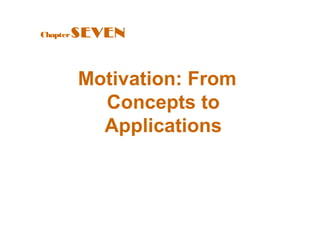
Motivation 001
- 1. Chapter SEVEN Motivation: From Concepts to Applications
- 2. Job Design Theory Job Characteristics Model Characteristics: Characteristics: Identifies five job 1. Skill variety 1. Skill variety characteristics and their 2. Task identity relationship to personal 2. Task identity and work outcomes. 3. 3. Task significance Task significance 4. 4. Autonomy Autonomy 5. 5. Feedback Feedback
- 3. Job Design Theory (cont’d) • Job Characteristics Model – Jobs with skill variety, task identity, task significance, autonomy, and for which feedback of results is given, directly affect three psychological states of employees: • Knowledge of results • Meaningfulness of work • Personal feelings of responsibility for results – Increases in these psychological states result in increased motivation, performance, and job satisfaction.
- 4. The Job Characteristics Model Source: J.R. Hackman and G.R. Oldham, Work Design (excerpted from pp. 78–80). © 1980 by E X H I B I T 7–1 E X H I B I T 7–1 Addison-Wesley Publishing Co., Inc. Reprinted by permission of Addison-Wesley Longman, Inc.
- 5. Job Design Theory (cont’d) Skill Variety The degree to which a job requires a variety of different activities (how may different skills are used in a given day, week, month?). Task Identity The degree to which the job requires completion of a whole and identifiable piece of work (from beginning to end). Task Significance The degree to which the job has a substantial impact on the lives or work of other people.
- 6. Job Design Theory (cont’d) Autonomy The degree to which the job provides substantial freedom and discretion to the individual in scheduling the work and in determining the procedures to be used in carrying it out. Feedback The degree to which carrying out the work activities required by a job results in the individual obtaining direct and clear information about the effectiveness of his or her performance.
- 7. Examples of High and Low Job Characteristics Characteristics Examples Skill Variety • High variety The owner-operator of a garage who does electrical repair, rebuilds engines, does body work, and interacts with customers • Low variety A bodyshop worker who sprays paint eight hours a day Task Identity • High identity A cabinetmaker who designs a piece of furniture, selects the wood, builds the object, and finishes it to perfection • Low identity A worker in a furniture factory who operates a lathe to make table legs Task Significance • High significance Nursing the sick in a hospital intensive care unit • Low significance Sweeping hospital floors Autonomy • High autonomy A telephone installer who schedules his or her own work for the day, and decides on the best techniques for a particular installation • Low autonomy A telephone operator who must handle calls as they come according to a routine, highly specified procedure Feedback • High feedback An electronics factory worker who assembles a radio and then tests it to determine if it operates properly • Low feedback An electronics factory worker who assembles a radio and then routes it to a quality control inspector who tests and adjusts it Prentice Hall, 2003 7
- 8. Computing a Motivating Potential Score People who work on jobs with high core dimensions are People who work on jobs with high core dimensions are generally more motivated, satisfied, and productive. generally more motivated, satisfied, and productive. Job dimensions operate through the psychological states in Job dimensions operate through the psychological states in influencing personal and work outcome variables rather influencing personal and work outcome variables rather than influencing them directly. than influencing them directly.